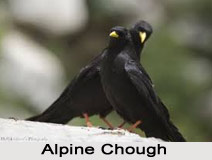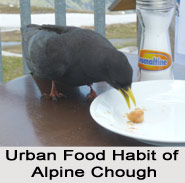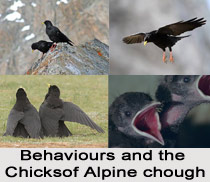 Alpine Chough is an Indian bird that bears a scientific name "Pyrrhocorax graculus" is a bird in the crow family, one of only two species in the genus Pyrrhocorax.
Alpine Chough is an Indian bird that bears a scientific name "Pyrrhocorax graculus" is a bird in the crow family, one of only two species in the genus Pyrrhocorax.
Breeds of Alpine Chough
The two subspecies of Alpine Chough breed in high mountains from Spain east through southern Europe and North Africa to Central Asia, India and China, and it may nest at a higher altitude than any other bird.
Eggs of Alpine Chough
The eggs of Alpine Chough have adaptations to the thin atmosphere that improve oxygen take-up and reduce water loss.
Size of Alpine Chough
Alpine Chough has glossy black plumage, a yellow bill, red legs, and distinctive calls. It has a buoyant acrobatic flight with widely spread flight feathers. The Alpine chough pairs for life and displays fidelity to its breeding site, which is usually a cave or crevice in a cliff face.
 Nests of Alpine Chough
Nests of Alpine Chough
Alpine Chough builds a lined stick nest and lays three to five brown-blotched whitish eggs.
Feeding of Alpine Chough
Alpine Chough feeds, usually in flocks, on short grazed grassland, taking mainly invertebrate prey in summer and fruit in winter; it will readily approach tourist sites to find supplementary food.
Flight of Alpine Chough
The flight of Alpine chough is swift and acrobatic with loose deep wing beats. Its high manoeuvrability is accomplished by fanning the tail, folding its wings, and soaring in the updraughts at cliff faces. Even in flight, it can be distinguished from red-billed chough by its less rectangular wings and longer, less square-ended tail.
Breeding Season of Alpine Chough
Alpine Chough breeds in mountains from Spain eastwards through southern Europe and the Alps across Central Asia and the Himalayan Mountain Range to western China. There are also populations in Morocco, Corsica and Crete.
 Nature of Alpine Chough
Nature of Alpine Chough
Alpine Chough is a non-migratory resident throughout its range, although Moroccan birds have established a small colony near Malaga in southern Spain, and wanderers have reached Czechoslovakia, Gibraltar, Hungary and Cyprus.
Forage of Alpine Chough
Alpine Chough always forages in groups, which are larger in winter than summer, and have constant composition in each season. Where food resources are restricted, adults dominate young birds, and males outrank females. Foraging areas change attitudinally through the year, depending on climatic factors, food availability and food quality. During the breeding season, birds remain above the tree line, although they may use food provided by tourists at refuges and picnic areas.



















